Rust Family Foundation: Archaeology Grants Program
Maneuvering the Middle:
How the middle stratum of Maya society adapted to the Classic collapse
Principal Investigator:
Anna BishopUniversity of California Los Angeles; Cotsen Institute of Archaeology
The 2018 project completed the first full excavations of La Luna, an ancient Maya residential group at the site of El Zotz in Guatemala (fig.1) that is at risk of heavy looting. Preliminary investigations at La Luna in 2017 suggested that the community there was “middle class”, a highly neglected demographic in ancient Maya studies. The goal of this project was to determine if La Luna was a ceramic production area, of which few have ever been found in the Maya region, and identify how people “in the middle” adapted to the breakdown and reorganization of socioeconomic systems.
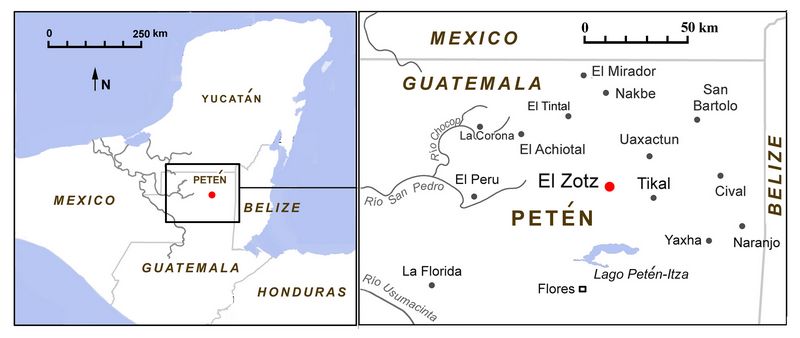
Fig.1: Map of the Peten region of northern Guatemala, showing the locations of El Zotz and neighboring Maya sites including the major center at Tikal.
Until recently, archaeologists assumed that ancient Maya society consisted of two classes, elites and commoners, when in reality the social spectrum included a diverse middle tier. Recent results from archaeological and epigraphic studies have demonstrated that some non-elites also possessed markers of high-status, and some individuals of lower status existed within the nobility (Chase and Chase 1996; Reed and Zeleznik 2016; Houston and Inomata 2009; Jackson 2013; Rossi et al. 2015).
However,despite the evidence of a middle stratum between the royal governing and the rural farming Maya, little is known about this demographic. Consequently, studies of the Classic Maya collapse have ignored the middle social stratum. However, the Maya middle strata could potentially be a key to understanding the sequence and effects of collapse. Unlike the royalty of urban centers or peasant farmers in remote communities, the Maya “middle class” would have negotiated relationships with people across the social spectrum and would have participated in both elite and non-elite systems.
Therefore, their response to the breakdown of elite society was likely unique and may reveal strategies used to navigate decline from both ends of the social hierarchy. It is impossible to fully comprehend social transformation if substantial demographics are ignored, therefore this project is critical to understanding ancient Maya society and its collapse.
Previous Work at the site:
The La Luna group was first identified during survey by the Proyecto Arqueológico de El Zotz (PAEZ) in 2015 and was the subject of a pilot investigation in 2017 (fig.2). While cleaning out illicit excavation units in three
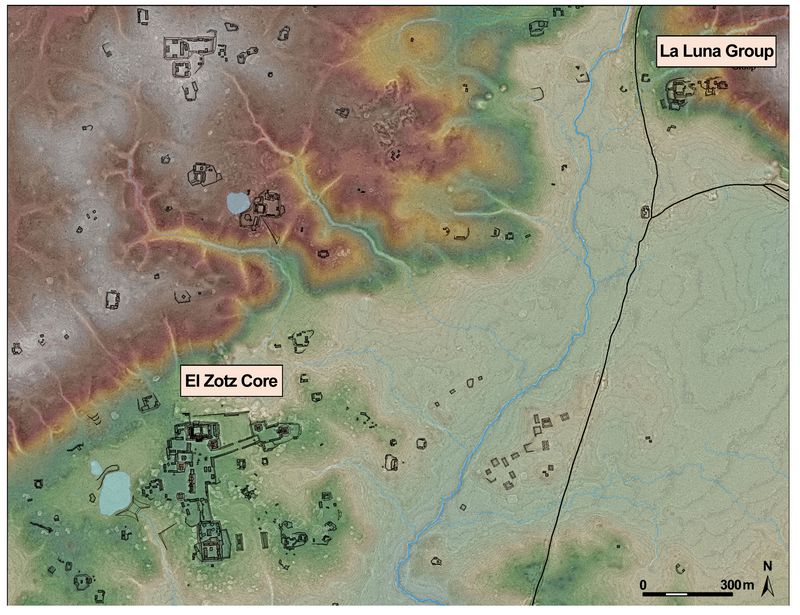 structures and digging test pits
in two locations, the team salvaged a vast amount of ceramic material.
From this it was determined that La Luna was occupied between the Late
and Terminal Classic periods (550-850 AD and 850-950 AD respectively),
which covers the peak and the decline of El Zotz.
structures and digging test pits
in two locations, the team salvaged a vast amount of ceramic material.
From this it was determined that La Luna was occupied between the Late
and Terminal Classic periods (550-850 AD and 850-950 AD respectively),
which covers the peak and the decline of El Zotz.Fig.2: Plan of El Zotz, showing the site core area at left, and the residential group area of La Luna at upper right (after T Garrison).
The removed location and simple architecture of La Luna are consistent with a non-elite family, but an abundance of high-quality ceramics in construction fill signaled impressive wealth. Combined, these suggested that the people living in La Luna were affluent commoners who occupied the middle stratum. Furthermore, the sheer quantity of polychrome sherds found at the group, over 200 in just two units, hinted that the individuals of this compound may have specialized in pottery production. Given that only six kilns have ever been positively identified in the entire Maya region, and only three sites have ever yielded evidence of specialized manufacturing, a ceramic production area at La Luna would be an exceptional find that would advance knowledge of Maya ceramics, craft production, and economics. Combined, wealth and possible occupational expertise would have provided unique assets for this middle tier family to navigate the collapse of the Maya elite.
The 2018 field season targeted trash pits for excavation to acquire a large quantity of material from the daily practices of the local population, and to search for ceramic production waste. In addition, a series of looter’s trenches were cleared out to recover materials that were missed and discarded by looters, and to properly stabilize the tunnels. All of this work also functioned to deter further looting at La Luna through the official presence it established at the complex. This project was carried out under the purview of PAEZ and overseen by director Dr. Tom Garrison and codirector Lic. Yeny Gutierrez. The present funds were used to finance the excavations at La Luna and 14C dating for three carbon samples.
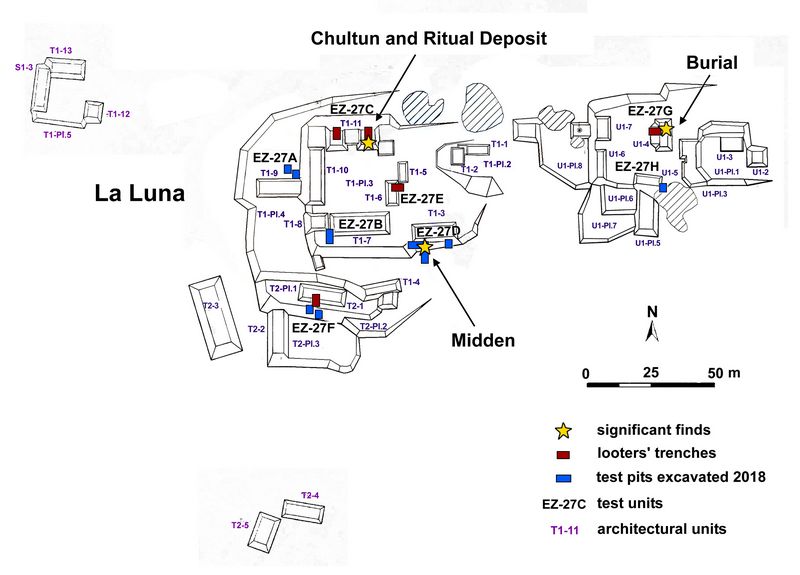
Fig.3: Map of 2018 excavations at La Luna. Blue rectangles represent excavation units, stars denote significant features (Base map – T. Garrison).
2018 Funded Project (RFF-2018-74)
Goals:
The three main goals of this project were to;
1) Counteract and stabilize the effects of looting at the La Luna group
2) Determine whether the group was in fact a ceramic production area
3) Excavate materials to establish what resources a “middle class” community
utilized in periods of stability at El Zotz, and how the community used those
assets in a period of turbulence and socioeconomic uncertainty
The first goal for this project was achieved swiftly: within four weeks two teams of workers cleaned out and backfilled five looter’s trenches. The high-quality ceramics and the easily penetrable, modest architecture at La Luna (fig.3), combined with proximity to a logging road, has made the group a target for extensive looting. Such looting operations target burials inside structures for their precious grave goods, especially finely painted vessels, which are abundant at the complex.
To complete the second project goal, architectural fill from looter’s trenches and refuse from test pits were examined for ceramic production waste. A high quantity of polychrome sherds recovered in 2017 suggested that the people at La Luna may have been producing these vessels themselves. If the community at La Luna was a kinship group of elite craftsmen it would explain how individuals of otherwise modest means came to possess these specific luxury items. Following this hypothesis, in the 2018 field season we searched for indices of artisanal pottery production. The kinds of waste typically associated with manufacturing pottery include fired lumps of clay, broken molds, misfired pots (wasters), paint pots, and large quantities of ash.
Unfortunately, none of these signs of craftwork were uncovered in refuse or construction fill around the complex, so we determined it was unlikely that La Luna was the location of a ceramic production area.
The final goal of this project then was to excavate materials for a comparison between the resources that a “middle class” community possessed in the Late Classic versus the Terminal Classic. The team successful in recovering a wide range of quotidian objects and a small collection of ritual offerings that will reveal information about the practices of the people at La Luna during these periods. However, while the primary action was achieved, performing a diachronic analysis between the Late and Terminal Classic materials excavated at La Luna proved to be challenging. While the occupation at La Luna did extend into the Terminal Classic, it does not appear to have continued for very long. Because the delineation between the very end of the Late Classic and the early Terminal Classic is blurry, it is difficult to clearly define the short occupation at La Luna in the Terminal Classic, or to compare resources between the Late and Terminal Classic. In light of these chronological limitations, in addition to the status symbols encountered during excavations and the absence of ceramic production, a new research question was devised to understand the community at La Luna using the materials that were excavated.
Methods and Findings: Excavations
Over the course of excavations five looter’s trenches were cleared out and stabilized (fig. 4a+b) and five structures were investigated for refuse with 1x1 m test pits (fig.4c). This work was carried out by four pairs of excavators.
EZ-27A (Structure T1-10): This house mound located on the main terrace of the La Luna complex was investigated for potential refuse areas. Two test pits
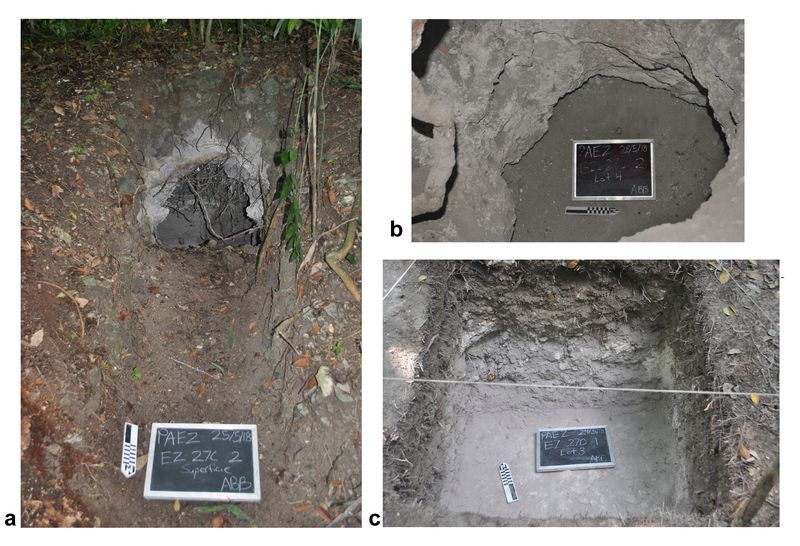 were excavated on the slope
behind the structure, on its west side, yielding a range of artifacts
including ceramics, lithics, and obsidian, but none in significantly
large quantities. While this location does appear to have accumulated
domestic refuse, it was not large enough to qualify as a trash pit.
Both test pits were excavated to bedrock, EZ-27A-1 at a depth of 0.78 m and EZ-27A-2 a depth of 1.6 m.
were excavated on the slope
behind the structure, on its west side, yielding a range of artifacts
including ceramics, lithics, and obsidian, but none in significantly
large quantities. While this location does appear to have accumulated
domestic refuse, it was not large enough to qualify as a trash pit.
Both test pits were excavated to bedrock, EZ-27A-1 at a depth of 0.78 m and EZ-27A-2 a depth of 1.6 m.Fig.4a + b: Looters' trenches. Fig.4c: Test pit.
EZ-27B (Structure T1-7): This house mound on the main terrace was also test pitted in search of domestic refuse. The first unit uncovered what appeared to be architectural blocks and a floor from the corner of T1-7, so a second unit was extended to confirm. After verifying the architectural nature of the features in these units, the sub-operation was closed because permits did not allow for the investigation of architecture. Artifacts recovered from these units, including ceramics, lithics, obsidian, and a figurine fragment, were most likely from loose construction fill. Unit EZ-27B-1 was excavated to a depth of 0.68 m and EZ-27B-2 was excavated to a depth of 0.5 m.
EZ-27C (Structure T1-11): This house mound on the main terrace adjoins with structure T1-10 and frames the north end of the central plaza at La Luna. Two extensive illicit tunnels that perforated the structure were cleaned out at length. The layers of architectural fill in EZ-27C-1 (the western-most unit) were indistinct and at best could be separated into two levels. In contrast, the profile of EZ-27C-2 (the eastern-most unit) was slightly better defined, with multiple layers of fill, but with only a small section of extant stucco floor and a few stones forming a possible wall. Both units were filled with a high volume of debris and cultural material, including ceramics (2,275 sherds in total, weighing 74 kgs.), lithics, obsidian, faunal remains, figurine fragments, shell, and carbon. Within this construction fill were many fragments of elite ceremonial vessels, as well as a carved shell glyph. Unit EZ-27C-1 was approximately 6.6 m. long and 3 m. deep, while EZ-27C-2 was approximately 8.1 m. long and 3.6 m. deep.
A key feature uncovered during excavations was a partially undisturbed chamber carved into the bedrock (also called a chultun) underneath EZ-27C-2. It appeared that looters identified the entrance to the chultun, however, the soil inside
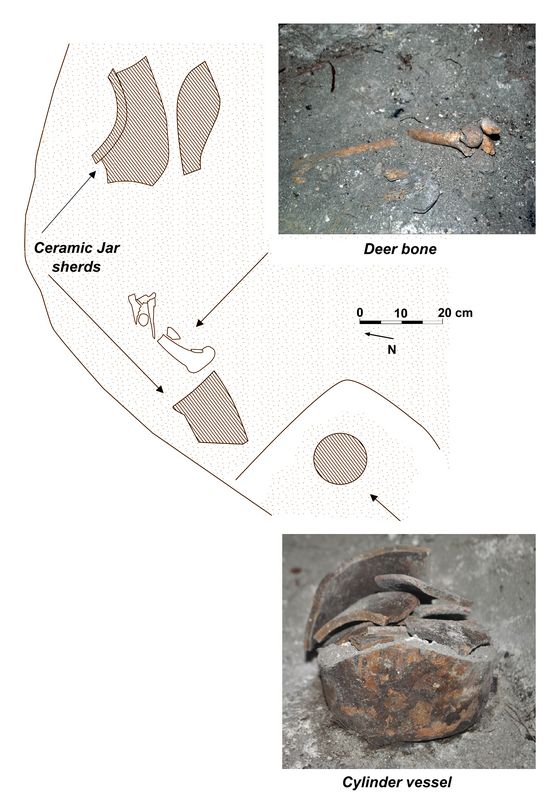 was densely compact and seemingly
unexcavated. This context yielded an in situ ritual deposit consisting
of bone fragments, a grinding stone, sherds from large jars and
polychromes, large amounts of charcoal, and most importantly, a cylinder
vessel placed on the floor of the chamber. These items are all
consistent with objects frequently included in Classic Maya ritual
deposits, and the quantity of charcoal and patches of darkened soil
within the chamber suggest that at some point a fire was lit inside the
chultun. Two charcoal samples were collected for radiocarbon dating
from different lots at approximately the same depth within the chultun.
While the original purpose of chultuns is debated, it was not uncommon
for the Maya to place sacred offerings or burials inside these chambers
towards the end of their use life, or to even use them as trash
receptacles in their final phases.
was densely compact and seemingly
unexcavated. This context yielded an in situ ritual deposit consisting
of bone fragments, a grinding stone, sherds from large jars and
polychromes, large amounts of charcoal, and most importantly, a cylinder
vessel placed on the floor of the chamber. These items are all
consistent with objects frequently included in Classic Maya ritual
deposits, and the quantity of charcoal and patches of darkened soil
within the chamber suggest that at some point a fire was lit inside the
chultun. Two charcoal samples were collected for radiocarbon dating
from different lots at approximately the same depth within the chultun.
While the original purpose of chultuns is debated, it was not uncommon
for the Maya to place sacred offerings or burials inside these chambers
towards the end of their use life, or to even use them as trash
receptacles in their final phases.Fig.5: Ritual deposit beneath EZ-27C-2.
EZ-27D (Structure T1-3): This house mound, also on the main terrace, was investigated for domestic refuse with a series of seven test pits on the slope behind the structure (on its south side). Here a dense trash pit (also called a midden) was located at the southwest corner of the mound in unit EZ-27D-1, so the test pit was extended through units EZ-27D-3, 4, 5, 6, and 7. Here a large quantity of ceramic was located (5,056 sherds in total, weighing 124.2 kgs.), in addition to lithics, obsidian, faunal remains, and figurine fragments. Unit EZ-27D-2 was placed at the southeast corner of structure T1-3 to ascertain if the midden extended to the other end of the mound. While there was domestic refuse (ceramics, lithics, obsidian) in this location, the materials recovered did not match the density of artifacts in the southwest corner. However, it is important to note that a heightened quantity of lithics were removed from this unit (79 fragments), suggesting possible stone tool production.
EZ-27E (Structure T1-6): This mound on the main terrace limits access to the central plaza at La Luna from its east side. Workers cleaned out the northern-most of three looter’s tunnels (EZ-27E-1) that pierce the structure to reveal a clear stucco floor separating layers of fill, and large architectural slabs stacked upright in a possible wall. Materials recovered in the mixed fill included pottery and lithics. This trench was 3.2 m. long and 2 m. deep.
EZ-27F (Structure T2-1): This structure is located on the bottom terrace of La Luna, and was investigated by clearing a looter’s tunnel and test pitting the slope directly south of the mound. Unit EZ-27F-1 is the third of four trenches (moving east-west) in this building. The stratigraphy is a poorly-defined layering of fills with a few short sections of deteriorated stucco floor and no clear walls. The trench revealed ceramic sherds and lithic fragments, and was measured at 3.72 m. long and 1.8 m. deep. Next two test pits were excavated behind structure T2-1 in search of refuse. Neither of these units were particularly fruitful, yielding some ceramics, and a small amount of lithic and obsidian fragments. Both EZ-27F-2 and EZ-27F-3 reached bedrock at a depth of 0.74 m.
EZ-27G (Structure U1-4): While exploring the top terrace workers cleared out an illicit excavation in the center of structure U1-4. This trench exposed a patch of stucco floor almost a meter in length, as well as various layers of hard to moderately compacted fill. Workers recovered ceramics, lithics, obsidian, shell, and faunal remains. The tunnel was found to be 4.2 m. long and 1.4 m. deep. At the end of the unit workers uncovered the partial remains of an adult male likely over 35 years of age with compressed vertebrae (Scherer in press). However, the disturbed context and absence of intact grave goods prevented further interpretation.
EZ-27H (Structure U1-5): Finally, a test pit was placed on the top terrace behind structure U1-5, which abuts with a possible quarry ditch. This mound was selected for probing because the location adjacent to a ditch was primed for disposing refuse. However, the bedrock here was very shallow, and only a small volume of ceramics and lithics were recovered. The test pit reached bedrock at a depth of 0.39 m.
Results:
General Architecture: The quantity and quality of materials uncovered around La Luna suggests the main occupation of the complex was on the middle terrace around its central plaza. The structures themselves were apparently built with mediocre materials and skill. Few extant features of the architecture remained, predominantly small sections of floor and a few large blocks that may have once been part of walls. The quality of this architecture is similar to commoner house mounds found around the core of El Zotz in the Terminal Classic (de Careteret 2015), and differs drastically from the elite residences of the acropolis (Newman 2012).
Methods and Findings: Lab Work
In total, 8,668 ceramic sherds (weighing 224 kgs.) were excavated and analyzed from La Luna. Moreover, materials undergoing analysis by project experts include 334 lithic objects, 215 bone fragments, 64 pieces of obsidian, 12 shell fragments, and 7 clay figurines. These materials are housed in the PAEZ lab, located in San Lucas, Guatemala.
Type-Variety-Mode:
Type-variety-mode classification is a standard form of Maya ceramic analysis (Sabloff 1975) that enables distinctions between time periods and regions. It focuses on surface decoration (slip, incisions, impressions), and elements known as modes that note shape, width, function, and vessel features (e.g., spouts and feet). This allows ceramicists to date contexts based on the age of ceramics in each context. Furthermore, by sorting types and varieties, one can distinguish between pottery of different influences or origins. The form of impressions on a vessel, for example, can indicate whether a potter was inspired by traditions from Tikal versus the Snake Kingdom (Forné 2012), while painting styles can be traced back to distinct workshops (Reents-Budet et al. 2010). Finally, analysis of decoration and modes can indicate the range of wealth and daily activities carried out at La Luna, by distinguishing between different categories of vessel function: (1) utilitarian containers used for storage or cooking, (2) monochrome pottery used for serving food, and (3) prestige polychrome and fine paste vessels used for special occasions.
Ceramic types correspond to different chronological phases. The phases that were represented in the material at La Luna included Tepeu 1 (550-700 AD), Tepeu 2 (700-850 AD), and Tepeu 3 (850-900 AD), confirming that the complex was inhabited throughout the Late Classic and into the early Terminal Classic. All units excavated possessed artifacts dating to the general Late Classic, however those units with a high quantity of ceramics, namely the looter’s trenches in structure T1-11 (EZ-27C-1 and EZ-27C-2) and the trash pit units behind structure T1-3 (EZ-27D-1, EZ-27D-2, EZ-27D-2,EZ-27D-3, EZ-27D-4, EZ-27D-5, EZ-27D-6, and EZ-27D-7), yielded more precise dates.
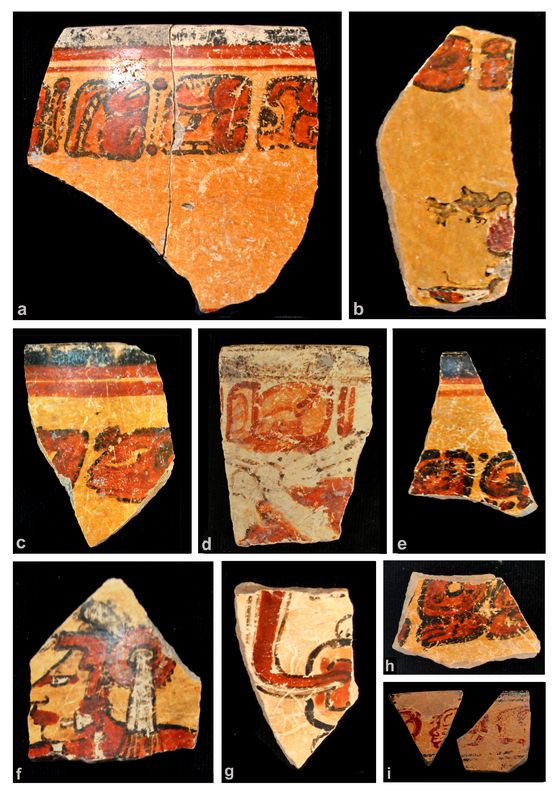 The polychrome pottery retrieved from
structure T1-11 displayed iconography and vessel forms popular in the
second half of the Late Classic (Tepeu 2), indicating that the
structure was certainly occupied at this time just before El Zotz went
into decline. Because the ceramics from these illicit trenches were
mixed up in the backfill left by looters, it is impossible to piece
together which sherds came from the earliest construction of the house
mound, however, the chultun found below T1-11 did provide a number of
clues as to when the dwelling was first built. Pottery in this chamber
possessed design elements from the ceramic phases Tepeu 1 and 2. This
material suggests that the first deposits in this chultun were placed
in the first half of the Late Classic, and the practice continued into
the second half of the Late Classic, until structure T1-11 was built
over the entrance. Radiocarbon dates later corroborated this
supposition, confirming then that this particular building was likely
constructed sometime between 700-850 AD.
The polychrome pottery retrieved from
structure T1-11 displayed iconography and vessel forms popular in the
second half of the Late Classic (Tepeu 2), indicating that the
structure was certainly occupied at this time just before El Zotz went
into decline. Because the ceramics from these illicit trenches were
mixed up in the backfill left by looters, it is impossible to piece
together which sherds came from the earliest construction of the house
mound, however, the chultun found below T1-11 did provide a number of
clues as to when the dwelling was first built. Pottery in this chamber
possessed design elements from the ceramic phases Tepeu 1 and 2. This
material suggests that the first deposits in this chultun were placed
in the first half of the Late Classic, and the practice continued into
the second half of the Late Classic, until structure T1-11 was built
over the entrance. Radiocarbon dates later corroborated this
supposition, confirming then that this particular building was likely
constructed sometime between 700-850 AD.Fig.6: Polychrome pottery from 2018 La Luna excavations: a) Pseudoglyph rim text.
b) Hummingbird feeding out of flower in headdress. c) Section of Primary Standard Sequence inscription around vase rim. d) Sherd depicting a head with headwrap, with an inscription above detailing a section of the Primary Standard Sequence. e) Partial El Zotz earspool emblem glyph. f) Profile of adorned figure. g) Figural design. h) Section of Primary Standard Sequence inscription – “drinking cup” (yuk’ib). i) Section of Primary Standard Sequence inscription (A. Bishop).
In contrast, the ceramics excavated from the trash pit behind structure T1-3 dated to both phases of the Late Classic (Tepeu 1 and 2) and the beginning of the Terminal Classic (Tepeu 3). The strongest indicators of a Terminal Classic occupation came from sherds made of a fine orange fabric, wh
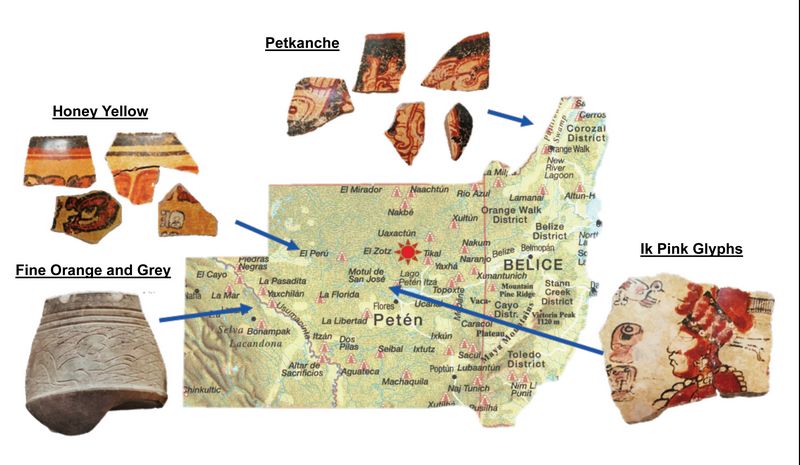 ich
was produced in the Usumacinta region to the south, and only imported
into the Petén after the lowlands began to decline. Alongside this fine
orange were other vessel forms and thin, eroded slips characteristic of
the changing ceramic tradition in the Terminal Classic. These confirmed
that the residents of structure T1-3 remained there slightly longer
than the family that inhabited T1-11, and that overall La Luna was
occupied in both the height and fall of El Zotz.
ich
was produced in the Usumacinta region to the south, and only imported
into the Petén after the lowlands began to decline. Alongside this fine
orange were other vessel forms and thin, eroded slips characteristic of
the changing ceramic tradition in the Terminal Classic. These confirmed
that the residents of structure T1-3 remained there slightly longer
than the family that inhabited T1-11, and that overall La Luna was
occupied in both the height and fall of El Zotz.Fig.7: Sources of imported polychrome pottery.
Type-variety-mode classification also identified a number of sherds that appear to have been imported (fig.7). Excavators uncovered pieces of Petkanche pottery, a style that originated from northwest Belize/southeast Quintana Ro (Ball 1977), and Honey Yellow pottery, a high-gloss polychrome that is believed to have been produced at El Peru (Eppich, pers. com., July 28 2018). Other sherds painted with rose-pink glyphs and an intricately dressed court member originated from Motul de San Jose (also known as the Maya site Ik), which is famous for its sophisticated polychrome vessels that were used as political gifts (Just 2012). Finally, the fine orange fragments mentioned above would have been imported up to the Petén from the Usumacinta region. All of these objects signal different ties that the people of La Luna had to other cities, either through trade or diplomacy. This indicates that the residents of La Luna were in fact quite cosmopolitan, and most likely possessed political relationships with sites such as Motul de San Jose. Furthermore, the quantity and variety of imported ceramics is highly unusual for El Zotz outside of the main acropolis, suggesting that the occupants of La Luna were as well connected as the El Zotz central nobility.
Finally, the function of the pottery excavated at La Luna can be identified, based on its surface decoration and forms. The quantity of luxury vases in particular was very
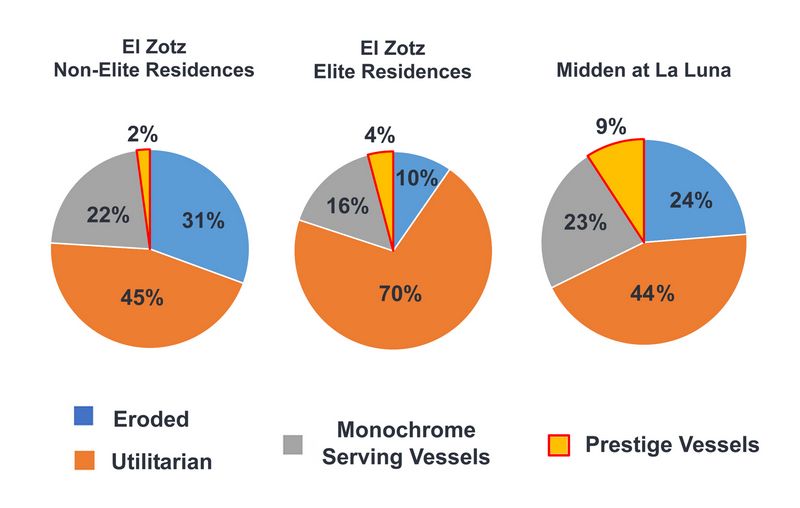 high (see
examples in figs. 6+9) compared to utilitarian pots and monochrome
serving vessels. A survey was accordingly made of the vessel usage at
La Luna versus other residential groups around El Zotz.
high (see
examples in figs. 6+9) compared to utilitarian pots and monochrome
serving vessels. A survey was accordingly made of the vessel usage at
La Luna versus other residential groups around El Zotz.Fig.8: Ratio of Prestige ceramics from Residences at El Zotz during the end of Late and early Terminal Classic.
Statistics from contemporary elite residences show that about 3-4% of the total ceramic assemblage at these groups was made up of prestige vessels (polychrome and fine paste pottery). In contrast, the trash pit at La Luna contained over double this rate, with 9% prestige pottery out of the whole assemblage (fig.8). Given that prestige ceramics were mainly used for ceremonies, the difference between the ratio of luxury vessels at La Luna and the El Zotz core suggests that inhabitants of La Luna were not only vastly wealthy but also very ritually active within their living space. Combined, all the data gathered from this type-variety mode analysis led to the development of new project goals.
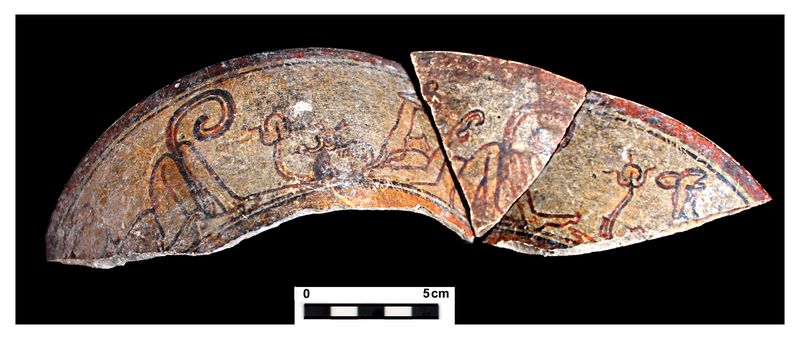
Fig.9: Rim sherds of polychrome vessel with figural design, showing a reclining monkey anthropomorph holding Chaahk’s axe, wearing diadem and pendant (A. Bishop).
Iconography:
Sherds with painted and incised iconography from the 2017 and 2018 seasons at El Zotz, as well as from other contemporary locations around El Zotz, were photographed and recorded using descriptions and terms from the original Uaxactun ceramic typology (Smith 1955). Comparisons of the abstract designs and figural images (fig.9) on these ceramics will indicated which themes are most common at La Luna and surrounding contexts of El Zotz at this time. This data should reveal information about the identity of the elite families at La Luna.
Petrography:
A total of 60 pottery samples were selected for petrographic analysis, where rock particles are identified in ceramic pastes using a polarized microscope. This can enable identification of where a vessel was made, including imports made with non-local materials. This analysis will complement the type-variety-mode classification in detecting exotic ceramics acquired through long-distance trade and determining their places of origin.
Petrographic samples were selected based on photographs of cross-sections of sherds from prestige vessels, the most likely to have traveled long distances. A total of 60 sherds were exported from the El Zotz collection, approximately 20 from La Luna, 20 from the Late Classic acropolis, and 20 from a Late and Terminal classic elite residence called Las Palmitas. Thin sections of these sheres will be used to perform mineral identification for each sample.
Radiocarbon Dating:
Three samples of charred material from La Luna were sent to Beta Analytic, Inc. for radiocarbon dating. Two of these were taken from the chultun below structure T1-11 (EZ-27C-2) within the context of the ritual deposit. The samples dated to 608-688 AD (95% probability) and 652-768 AD (95% probability), i
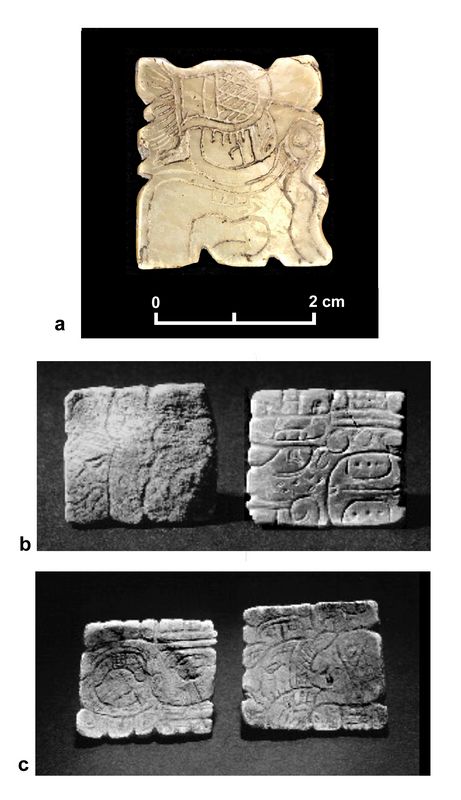 ndicating that the ritual offerings in this chamber were
made as early as the first half of the Late Classic (Tepeu 1). This is
consistent with the ceramics found in the chultun and verified that
structure T1-11 was built over the entrance to the chamber no earlier
than 652 AD, most likely in the 8th century.
ndicating that the ritual offerings in this chamber were
made as early as the first half of the Late Classic (Tepeu 1). This is
consistent with the ceramics found in the chultun and verified that
structure T1-11 was built over the entrance to the chamber no earlier
than 652 AD, most likely in the 8th century.Because no other contexts yielded burnt materials for dating, a carbon sample collected from a test pit in the main plaza at La Luna in 2017 was analyzed with the remaining funds for carbon dating. Surprisingly, this sample dated between 375-203 BC (95% probability), which falls under the Late Preclassic period (400 BC – 250 AD) at El Zotz. Because no other material from this time has been uncovered at La Luna, it is likely that this carbon represents a passing human presence at the group as opposed to a permanent occupation. However, it is noteworthy that human activity occurred at La Luna before El Zotz was even constructed in the Early Classic (250-550 AD).
Fig.10: (a) carved shell glyph from La Luna, compared with (b,c) those from Piedras Negras.
Key Artifacts:
A number of significant finds at La Luna have led to the revision of previous notions about the community that lived there. One such key item was the aforementioned shell glyph uncovered in structure T1-11 (EZ-27C-1) (fig.10a). Although few shell glyphs have been found in the Maya region, similar ones were excavated at Piedras Negras in the tombs of sub-royal aristocrats (fig.10b,c). However, none have been found outside of elite contexts. T
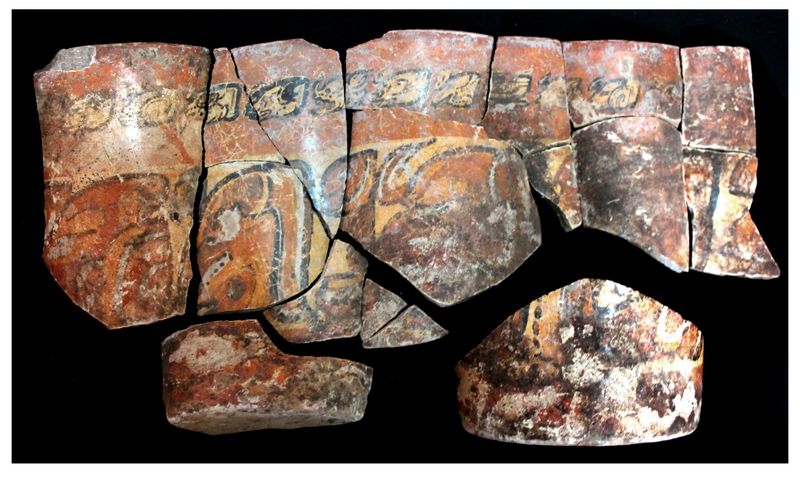 hese glyph carvings are believed to have been part
of a regal headdress or diadem, such as the one worn by Lady K’abel of
El Perú on stela 34 (Houston, pers. com., Sept. 9, 2018). The limited context and scarce nature of these pieces suggests
that they were an exclusively aristocratic possession, and certainly
out of place in a non-elite location.
hese glyph carvings are believed to have been part
of a regal headdress or diadem, such as the one worn by Lady K’abel of
El Perú on stela 34 (Houston, pers. com., Sept. 9, 2018). The limited context and scarce nature of these pieces suggests
that they were an exclusively aristocratic possession, and certainly
out of place in a non-elite location.Fig.11: Cylinder vase from ritual offering in chultun of T1-11 (A. Bishop).
Finally, the most impressive object excavated in the 2018 season was the cylinder vase that was placed in the chultun of structure T1-11 as a ritual offering (fig. 11).
The vessel is circumscribed at the top with a dedicatory sequence, which appears to continue into the main artistic frame with a series of large glyph heads. The sequence that circles the rim includes the emblem glyph of El Zotz, indicating that the original owner of the pot was a member of the El Zotz dynasty (fig.12). It is possible that the
 original owner lived at La Luna, or gifted the vase to someone
living at La Luna. Either way, the presence of this glyph suggests that
the families at this complex were directly tied to the local elite.
original owner lived at La Luna, or gifted the vase to someone
living at La Luna. Either way, the presence of this glyph suggests that
the families at this complex were directly tied to the local elite.Fig.12: Emblem glyph of El Zotz on cylinder vase.
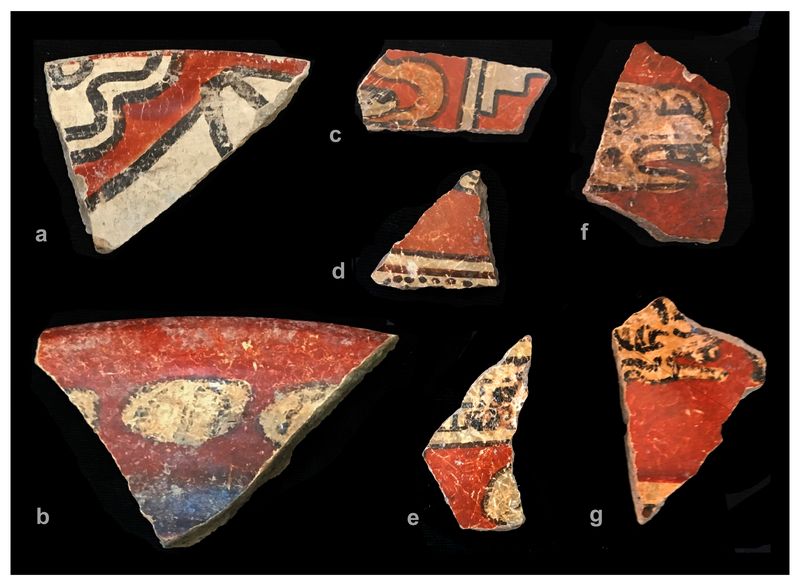
This supposition is further corroborated by sherds unearthed at the group that are painted in the Zotz Red style. The bright red backgrounds and supernatural creatures specific to this style decorate vases that belonged to local nobility, who are named in the vessels’ dedicatory texts (fig.13) (Czapiewska-Halliday et al. 2018). Because only members of the aristocracy appeared to own pots of this variety, the inhabitants of La Luna who possessed these vases were either nobility or closely connected to nobility.
Fig.13: Zotz Red sherds: a) Geometric design. b) Pseudoglyph band. c) Wahyl emitting fire scrolls from mouth. d) Unknown design. e) Figural design. f) Section of Primary Standard Sequence inscription. g) Section of Primary Standard Sequence inscription (A. Bishop).
Conclusions:
Overall, the excavations at La Luna in 2018 proved very fruitful and informative. A significant portion of the complex was investigated, almost half of the group’s structures across all three terraces. The architecture exposed by looter’s trenches was unsurprisingly underwhelming, but the materials unearthed in and around these house mounds was exceptional. The chultun and ritual deposit discovered below structure T1-11 provided an in situ glimpse into the religious activities that took place at La Luna in the Late Classic, while a trash pit behind structure T1-3 yielded the remains of daily life here during its peak and decline. Together these contexts and the others that were examined in 2018 produced an enormous collection of material that can speak to both the sacred and mundane at La Luna.
While the quantity of prestige ceramics uncovered in an initial investigation at La Luna in 2017 hinted that similar quality materials would be found in 2018, the objects excavated in 2018 surpassed those recovered previously. The original hypothesis about the “middle class” status of this community was tested against key artifacts such as the carved shell glyph and remnants of an Ik vessel, which have elsewhere only been found in elite contexts.
Additionally, current research shows that ceramics painted with certain features, such as emblem glyphs or Zotz Red imagery, were made specifically for members of aristocracy and therefore would only have been possessed by aristocrats or closely connected individuals. Such pieces at La Luna indicate a much stronger relationship between the residents here and the central court at El Zotz than previously thought.
Furthermore, while imported prestige pottery is not restricted to the Maya nobility,a preliminary review of the ceramic data shows that no other residential group excavated at El Zotz (elite or non-elite) possessed such a wide variety of exotic vessels. Similarly, the ratio of prestige ceramics at La Luna is unlike anything that has been excavated at other residences around El Zotz. The objects that this community possessed go beyond what is considered normal outside of palaces, and without its own means of production, it is difficult to explain how a middle-status group could have come to own a vast amount of luxury ceramics. However, the humble house mounds at La Luna and lack of any monumental art, architecture, or inscriptions still contradict the normal setting for a Maya aristocrat. Taken together, this new information suggests that the population at La Luna was not “middle class”, but possibly an atypical elite group.
Ongoing Plans:
Based on current findings, it is now proposed that an eccentric elite identity developed at La Luna in the period preceding the Maya collapse, as an alternative center of prestige. The development of this unconventional elite group, combined with contemporary shifts at the center of El Zotz at the end of the Late Classic, suggests that the political structure of the site changed in the 8th century; changes that are critical to understanding the Classic Maya collapse that occurred soon after. For this revised research, data will be sought to answer two questions: (1) how closely connected is the material culture of the elite households at La Luna to the central nobility at El Zotz? (2) based on this information, what was the internal elite structure at El Zotz before its collapse?
The investigations at La Luna from 2018 allow the tentative conclusion that the aristocracy diversified in the El Zotz region at the end of the Late Classic. Comparing the practices of the nobility at La Luna with those in other parts of El Zotz will reveal the different types of elites that arose at this center in the 8th century, and the political structure that was in place upon decline. Furthermore, a continued presence at La Luna is critical to preventing further ransacking of the complex, and an excavation of architecture in 2019 will facilitate the retrieval of grave goods in intact burials before they are located by looters.
The complete findings from the 2018 season are published in the PAEZ annual report, posted online at Mesoweb.com in spring 2019. Preliminary findings were discussed in a paper at the Simposio de Investigaciones Arqueológicas en Guatemala, and in a lecture at UT Austin’s Casa Herrera in Antigua, Guatemala, and in a paper at the annual meeting of the Society for American Archaeology in April 2019.
A complete interpretation of the results from this project is published in my dissertation, currently available here.
References:
Ball, Joseph W. 1977 The archaeological ceramics of Becan, Campeche, Mexico. Middle American Research Institute, Tulane University, New Orleans.
Becker, Marshall Joseph 2003 A Classic-Period Barrio Producing Fine Polychrome Ceramics at Tikal, Guatemala: Notes on ancient Maya firing technology. Ancient Mesoamerica 14(1): 95–112.
Carter, Nicholas 2014 Kingship and Collapse: Inequality and Identity in the Terminal Classic Southern Maya Lowlands. Brown University.
Chase, Arlen, and Diane Chase. 1996 A Mighty Maya Nation: How Caracol Built an Empire by Cultivating Its Middle Class. Archaeology.
Czapiewska-Halliday, Ewa, Nicholas P. Carter, Melanie J. Kingsley, Sarah Newman, and Alyce de Carteret. Understanding Social, Economic, and Political Change: The Ceramics of El Zotz. In An Inconstant Landscape: The Maya Kingdom of El Zotz,Guatemala, edited by Thomas G. Garrison and Stephen D. Houston. University of Colorado Press, Boulder.
De Carteret, Alyce 2015. Excavaciones en el Grupo I10 (Operación 25). In Proyecto Arqueológico de El Zotz Informe Final de 10ma Temporada de Campo, edited by Jose Luis Garrido, Yeny Gutiérrez Castillo, Edwin René Román Ramirez, Tom Garrison, and Stephen Houston.
de Carteret, Alyce 2017 Building Communities: The Craft of Housebuilding among the Classic Maya. Brown University..
Demarest, Arthur Andrew, Prudence M. Rice, And Don Stephen Rice. 2004. The Terminal Classic In The Maya Lowlands: Collapse, Transition, And Transformation. Boulder: University Press Of Colorado.
Forné, Melanie 2012 The very Late Classic Maya : ceramic research for the definition of an interregional level of economic interaction. In Annual Meeting of the Society for American Archaeologists. Memphis, TN.
Just, Bryan. 2012 Dancing into dreams : Maya vase painting of the Ik’ kingdom. In Princeton University Art Museum, Princeton, NJ.
Halperin, Christine, and Antonia E. Foias 2012. Motul De San José Palace Pottery Production: Reconstructions From Wasters And Debris. In Motul De San José: Politics, History, And Economy In A Classic Maya Polity, edited by Antonia Foias and Kitty Emery. University of Florida Press, Gainesville.
Houston, Stephen D., and Takeshi Inomata 2009. The Classic Maya. Cambridge University Press.
Jackson, Sarah E. 2013 Politics of the Maya court : hierarchy and change in the late classic period. University of Oklahoma Press.
Kingsley, Melanie 2014 In the Wake of “Collapse”: Life at El Zotz, Guatemala during the Early Postclassic Period. Brandeis University.
Kovacevich, Brigitte 2015 From the Ground Up: Househould Craft Specialization and Classic Maya Polity Integration. In Classic Maya Polities Of The Southern Lowlands : Integration, Interaction, Dissolution, edited by Damien B. Marken and James L.Fitzsimmons. University of Colorado Press, Boulder.
Newman, Sarah. 2013. Limpieza de Saqueos en la Acrópolis de El Zotz (Operación 22).In Proyecto Arqueológico de El Zotz Informe 7ma Temporada 2012, edited by Jose Luis Garrido, Tom Garrison, Edwin René Román Ramirez, and Stephen Houston.
Newman, Sarah 2015 Rethinking Refuse: A History of Maya Trash. Brown University.
Palka, Joel. 1997 Reconstructing Classic Maya Socioeconomic Differentiation and the Collapse at Dos Pilas, Peten, Guatemala. Ancient Mesoamerica 8(2).
Reed, David, and W. Scott Zeleznik. 2015 The Maya in the Middle: An analysis of subroyal archaeology at Copan, Honduras. In Human Adaptation in Ancient Mesoamerica, edited by Nancy Gonlin and Kirk D. French. University Press of Colorado.
Reents-Budet, Dorie. 1994 Painting the Maya Universe : royal ceramics of the classic period. Duke University Press in association with Duke University Museum of Art, Durham.
Reents-Budet, Dorie, Sylviane Boucher Le Landais, Yoly Palomo Carrillo, M. James Blackman, and Ronald L. Bishop. 2010 Codex-Style Ceramics : new data concerning patterns of production and distribution. XXIV Simposio de Investigaciones Arqueológicas en Guatamala. 2010.
Rossi, Franco D., William A. Saturno, and Heather Hurst 2015 Maya Codex Book Production and the Politics of Expertise: Archaeology of a Classic Period Household at Xultun, Guatemala. American Anthropologist 117(1): 116–132.
Sabloff, Jeremy. 1975 Excavations at Seibal, Department of Peten, Guatemala. Vol. 2: Ceramics. Peabody Museum of Archaeology and Ethnology, Harvard University, Cambridge Mass.
Scherer, Andrew. In Press. Osteología De El Zotz: Entierros de la Temporada de Campo 2017 y Resultados Preliminares de los Isotopos Estables de Entierros de la Temporadas 2014 y 2015. In Proyecto Arqueológico El Zotz Informe Final 2017, edited by Jose Luis Garrido López, Thomas G. Garrison, and Yeny Gutierrez. Report being submitted to the Guatemala Instituto de Antropología e Historia.
Smith, Robert 1955 Ceramic sequence at Uaxactun, Guatemala. Middle American Research Institute, New Orleans.
Walker, Caitlin A H. 2010 A Ceramic Chronology of the El Zotz Region, Petén, Guatemala. Brown University..
Recent Foundation grants: general Archaeology Grants Program w/map
Copyright © 2022 Rust Family Foundation